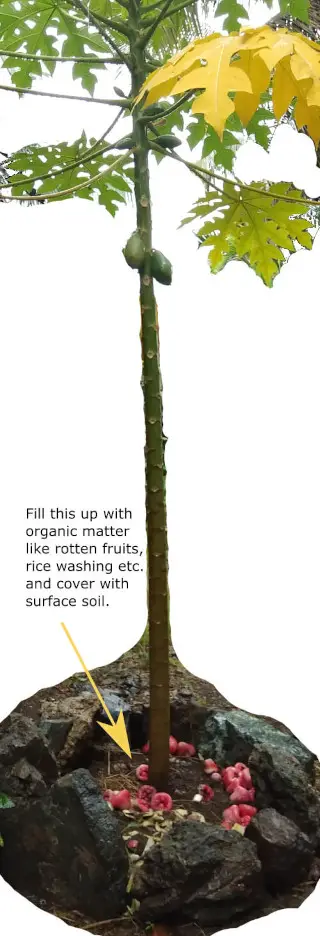Nobody has ever talked about FASP, a new idea that cropped up in my mind while trying to do some gardening at home while under quarantine due to COVID-19. Of course, nobody knows about it, as that’s an original idea derived from my insights a few days ago. I am sharing this innovative gardening idea with gardening enthusiasts as a home technology that requires meager input but replete with fruits – literally. No tricks, it works.
This article introduces this innovative gardening idea to integrate into your gardening activities using available materials at home—no need to buy costly inputs. Just anything organic or something that decomposes in your home will do.
What is the FASP Approach?
FASP is an acronym for the Find-and-Support-a-Plant Approach. I came up with this innovative gardening idea given my phytoremediation and lithic mulching background, which I learned while on home quarantine due to COVID-19. You can source everything as input to your small garden that can continually supply you with needed food to tide away from the constraints of confinement and avoid getting out to buy food.
The principle of FASP is simple: find any edible plant growing in your yard and support that plant until it grows to maturity and bears fruit. This principle bodes well with the knowledge I gained in my training on phytoremediation of mined out or barren areas where agriculture is difficult. I added lithic mulching technology, an ancient gardening method that uses rocks to create a favorable environment for the plant to grow.
I describe both techniques in the succeeding sections.
Phytoremediation Technique
In the remediation of a mined-out, barren site, phytoremediation starts with finding a plant, preferably the grassy type, that grows abundantly in the area. That means that that plant has the qualities to survive in such a harsh environment. Hence, whatever that plant is, seeds from it may be obtained and propagated before re-transplantation to the rehabilitation site. Survival is ensured because of the previous adaptation made by the source plant. As simple as that.

Using the same principle, I looked around to find an edible plant that grows in my yard that grows well and shows promise of surviving. I saw potential plant candidates that perhaps grew from discards in our kitchen, unwittingly brought by animals like birds from their droppings, or carried by floodwaters during heavy rains.
Last year, I saw tomato seedlings growing near the place I used to bury organic refuse from the kitchen. I transferred the tomato seedlings as they were so dense in the garbage disposal site to my lithic mulch structure (discussed more fully in the next section) and let them grow. I also discovered a pepper plant (siling labuyo or Capsicum frutescens) next to the concrete fence I had erected a year ago.
The pepper has already grown to about a foot, so I decided to support its growth by surrounding it with rocks and adding vermicast to the soil covering the root portion. It grew so well and supplied us with more than a kilo of small but intensely aromatic fruits. We had a sustainable supply of hot pepper for several months that added flavor to adobo. They made the vinegar hotter (locally called sinamak), an ideal dipping sauce or sawsawan for broiled fish. Your ears feel hot as you consume more of it.
And I realized the sweet potato or camote (Ipomoea batatas) I planted a year ago in the lithic mulch during the start of the pandemic has already grown profusely in the lawn. I just let the creeping vine expand its territory in the grounds, gathering nutrients from the poor soil in the process from the point of attachment. Hence, we have a continuous supply of camote tops to add flavor to our soup or blanched for a more healthy side dish.
A week ago, I also noticed two papayas growing near the fence (see Figure 1), one already with two fruits along the stem and even more a few inches above them. I cannot recall, though, if I have eaten these fruits for the past months. Maybe some birds brought it there.
Remembering my experience with the hot pepper, I thought of surrounding the plant with rocks. I also started to add organic refuse from our kitchen, such as rice washings, peelings from vegetables like chayote or chayote (Sechium edule), peaches, apples, banana, radish, among others. Sometimes when I got enough time, I chopped the peelings to bits to hasten decomposition. Chopping or mashing the organic materials increases the surface area for bacteria to act on. It speeds up the decomposition process, thus make available the nutrients therein for the papaya to use.
The water apples that fall from the trees and inedible material from those we ate make up a portion of the trash. These fruits quickly decompose, so I toss them into the pile of organic material and cover them with surrounding sandy soil. The water apple tree itself provides our Vitamin C needs starting from the middle of April. The tree I planted 20 years ago paid off.
Lithic Mulching Principle
For the other plants (except camote), I laid down rocks to surround the plant’s stem. I added vermicast to the enclosed root portion for the pepper plant that grew near our concrete fence. I placed rotten fruits and discards from the kitchen inside the area surrounded by the rocks and covered them with the surrounding soil to keep the flies away from the papaya. For the growing banana, I just let them grow along the drainage from the kitchen. In the process, the plants collect nutrients from the flowing sewage. They grow so well.
Why did I use rocks to surround the stem of the plant being supported?
This innovative gardening idea originated from the folks at Easter Island, an isolated island and special territory of Chile in the southeastern Pacific Ocean, at the southeasternmost point of the Polynesian Triangle in Oceania. The natives call the circular rock structure that creates an environment conducive to plant growth a manavai.
The rocks protect the plant from the harsh elements and the wind and keep the nutrients inside the enclosed structure intact. They also provide an ideal soil temperature that encourages plant growth.
Most importantly, the structure also traps the vital moisture needed by the plants to grow, shielding the moist soil from easily drying out because the rocks or stones block the heat from the sun that hastens evaporation. The natural shade offered by the sun is particularly effective in barren places in islands without much vegetation, such as Easter Island.
In my experience, a lithic mulch structure need not be tall. The structures I built are about six inches high. These structures are already enough to support plants like tomatoes, mustard, water spinach, Malabar spinach, Chinese broccoli, pepper, and other vegetables. The vegetables grow so well (see how the vegetables thrive in my previous post on lithic mulching).
I never thought the innovative gardening idea could be this good while recalling those times when I was in the elementary grades doing some conventional gardening on raised beds as part of our extracurricular activities.
Outlook for FASP as an Innovative Gardening Idea
I am confident that the papaya I supported using organic material from the kitchen will grow stouter and bear more plump fruits. FASP based on phytoremediation plus lithic mulching is an excellent innovative gardening idea that could help us survive this pandemic.
Try the technique, and please tell me if it worked for you. This innovative gardening idea is an adaptation that I believe can help everyone struggling to find the much-needed food without putting themselves at risk. While waiting for the vaccine, why not find some rocks and rock your way to a productive gardening activity.
© P. A. Regoniel 11 May 2021




Thanks for your feedback Annabelle. Glad to know you finally had a paradigm shift knowing the benefits of enclosing the plant with stones.
My husband would always put stones or bricks around our plants or under our fruit trees and I would oppose and argue with him not to put those stones. Now I know he was doing right. Great information, it gives me a paradigm shift.